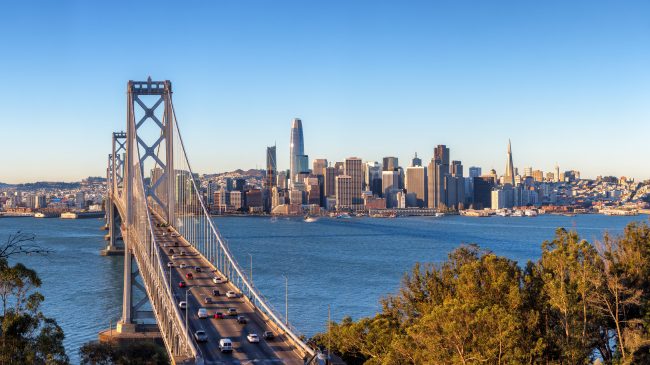Northern California transit providers have kicked off a new initiative named Link21, whose major objective is to build a second rail tunnel connecting San Francisco and Oakland. Link21’s larger mission is to improve transit service throughout a 21-county area that extends from Monterey Bay through the San Francisco Bay Area and to the Sacramento region.
According to the San Francisco Chronicle, the new rail crossing would cost an estimated $29 billion. The Metropolitan Transportation Commission and regional transit operators have already committed $210 million to plan the overall project.
When transit operators studied ridership trends in 2015, they observed a rapid growth in commuting across the San Francisco Bay between 2010 and 2014. A continuation of this trend would render existing infrastructure – including the existing Bay Area Rapid Transit (BART) tunnel and the Bay Bridge—insufficient to meet the needs of commuters from eastern suburbs to reach their places of employment in San Francisco.
But trends observed in the first half of the 2010s have not continued to the present day. Average weekday BART ridership actually declined from 410,847 in January 2015 to 388,922 in January 2020, prior to the coronavirus pandemic, despite the addition of new stations. By January 2021, the effects of COVID-19 shelter-in-place orders and the ability of much of the region’s workforce to work from home further reduced BART ridership to just 43,012.
BART management, rightly, does not expect all passengers currently working from home to return anytime soon. Its latest budget assumed that BART ridership in July 2022 would be only 65 percent of pre-pandemic levels, with an upper bound estimated at 75 percent.
Even prior to the COVID-19 pandemic, however, there were reasons to question whether local population growth and ridership would outstrip the existing tunnel’s capacity. In 2019, California’s Department of Finance projected that San Francisco’s population would rise slightly from 892,280 in 2020 to 1,005,762 in 2040. It also projected that Alameda and Contra Costa counties, the two major sources of Transbay Tube commuters, would see a population increase from a combined 2,845,985 in 2020 to 3,301,912 in 2040.
While 2040 is still nearly two decades away and a lot can change, the potentially permanent shifts to working from home mean those numbers now seem likely to be revised downward. Although San Francisco’s 2020 estimated population came in above the Department of Finance projections, it has seen a sharp fall in apartment rents during the pandemic, suggesting a population decline. Alameda and Contra Costa County population estimates fell below the 2020 projection, but these counties do not seem to be facing as much outmigration pressure during the pandemic.
Beyond the lack of population growth, corporate employees living in the Bay Area are less likely to commute to, and thus use BART in getting to, their San Francisco offices each day for the foreseeable future. This week, the city’s largest employer, Salesforce announced a new remote work policy. Declaring that “the 9-5 workday is dead,” the company said that most employees would be “in the office 1-3 days per week for team collaboration, customer meetings, and presentations.” Salesforce’s announcement follows other large San Francisco tech employers like Dropbox and Twitter in adopting more accommodative work-from-home policies. Meanwhile, the city’s biggest financial industry employers, Charles Schwab and Wells Fargo are in the process of downsizing.
BART is already working on a project to increase the capacity of its existing tunnel. Currently, the tunnel can handle up to 24 trains per hour with two-and-a-half-minute headway. In September 2020, the system awarded a $799 million contract to Hitachi Rail to install a new train control system, which will allow two-minute headways between trains, increasing the tunnel’s capacity to 30 trains per hour in 2032.
With stagnant-to-limited population growth and an increase in remote work, BART’s existing transbay tunnel is unlikely to return to anywhere close to its 2015 peak utilization in the next few years. Even if future ridership begins to return to previous peaks, BART already has the ability to run up to 25 percent more trains through that tunnel, thereby meeting increased demand. Further, with the opening of the Salesforce Transit Center in 2018, San Francisco now has a much greater capacity to accommodate Express Bus traffic from the Bay Bridge. Additional buses could serve many more East Bay commuters who are not conveniently located near BART stations.
Given the uncertainty around how long-term travel and commuting patterns may be permanently altered by the pandemic, reduced mass transit demand even before the pandemic, and previously increased BART and bus capacity, it seems wise to hit the pause button on funding or moving ahead with a second transbay train tunnel.

